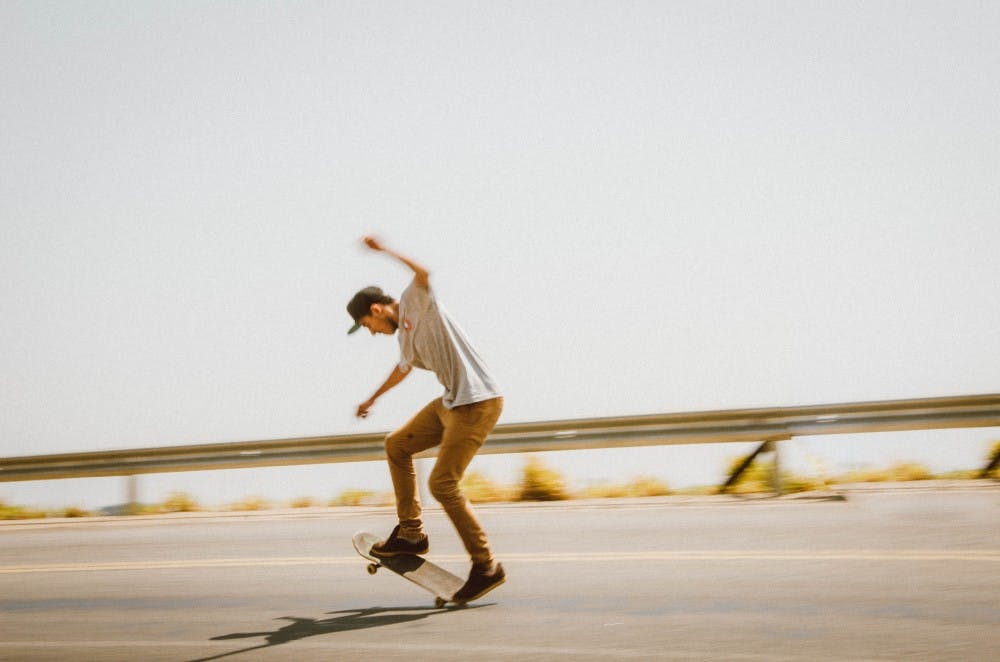I am neither an avid skateboarder nor a Tony Hawk skateboard fanatic, but in the past few years, I’ve grown increasingly interested in the subculture’s influence on fashion, arts and the community it holds together. Skateboard videos have claimed their own unique niche in the world of social media, where young, talented individuals showcase their tricks in oddly satisfying clips that are edited to match trending hip-hop songs. In fact, just last year, Jonah Hill made his directorial debut with Mid90s, a film about a 13-year-old skateboarder and the friendships he builds while venturing out to skateboard parks across Los Angeles. And even a few months before that, Chicago-based director Bing Liu released Minding the Gap, a gripping documentary that exposes personal stories behind a few skateboard friends that Bing himself grew up with in the small town of Rockford, Ill. Since then, Minding the Gap has been nominated for Best Documentary Feature at the upcoming 91st Academy Awards.
The documentary begins with Kiere Johnson and Zack Mulligan climbing up what seems to be a fire escape gated with a “No Trespassing” sign, exploring possible locations to test new tricks. In a few seconds, they both become wary of the unprotected platform and decide to climb back down to safety, giggling at their abrupt abandonment of the daring idea. Moments later they skateboard down empty streets under the afternoon sunlight, spiraling over ledges and curbs, quietly following each other as their skateboard wheels glide against the cement.
The documentary then formally introduces us to Kiere and Zack, both long time friends who met at a neighborhood skateboard park in their youth, where young Bing, a skateboarder himself, frequently stood behind his old camcorder, filming short, silly videos. The rocky, instantaneous cuts of his friends making jokes and smiling into the camera capture moments of pure, unhinged happiness. At the same time, the film features shots that young Bing managed to capture in moments of tension, such as the boys breaking their skateboards in displays of frustration that slowly ease into larger sources of conflict within each individual’s lives leading up adulthood.
In Minding the Gap, Bing returns behind the camera, no longer a young boy but a young man seeking answers to unanswered questions concerning Kiere and Zack’s life outside of skateboarding. Along the way, he reconciles with truths about his own life, ridden with broken family relationships and traumatic memories of domestic violence. Bing, returning to his home, sits down with his mother to discuss a past that he had suppressed, and the face to face conversation allows Bing to confront feelings toward his stepfather and mother that he had rarely considered. What Bing discovers, however, is that his painful experiences are not ones he carried alone — it is not until Bing finally asks Kiere and Zack about their lives that he learns of their experiences with negligence and abuse, personal stories that were never mentioned during years of shared skateboard sessions.
Trying to make ends meet by working as a roof mechanic, Zack, now father to a newborn baby, faces the harsh reality of finding his place as an individual with little opportunity in a society he deems as suffocating and conforming. Kiere, reaching the end of his teens, holds dichotomous feelings toward his family, coming to terms with his father’s death and a quest for independence.
The film makes it difficult to ignore questions of race as Kiere, a young black man, becomes more aware of his own identity separate from his white friends throughout. And yet, amidst these stories of both internal and external conflict, Bing interjects with clips of these young individuals on their skateboards, laughing and supporting each other in their attempts to master a new kickflip — barriers that are undone by a very special brotherhood. At one point in the film, Kiere says, “I could seriously be on the verge of having a f****** mental breakdown, but as long as I’m able to go skate then I’m completely fine.”
What begins with a few boys on a wooden board ends with an evolved story about life, shedding light on corners of real experiences that simply cannot explained by words. Perhaps the most memorable image that was left with me was that of a brief cut to one of Kiere’s skateboard with the words written on it: “This device cures heartache.” Skateboarding, to them, is not just a hobby but a form of individual and collective healing. Minding the Gap is a raw, emotional and powerful account that uncovers the delicacies of personhood that are too often masked by expectations of strength and resilience.





